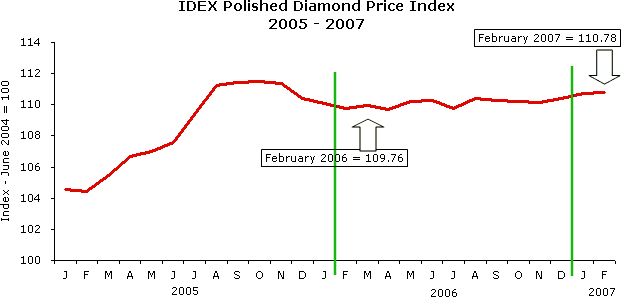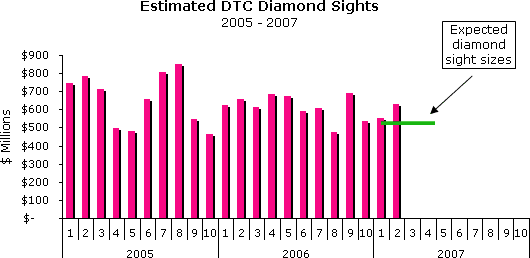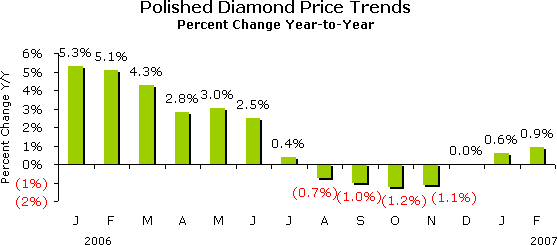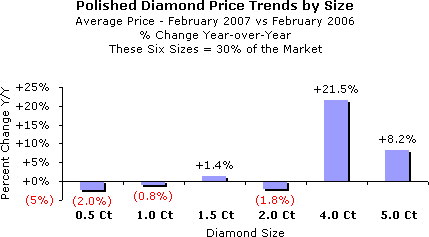IDEX Online Research: Polished Diamond Prices Continue to Increase
March 04, 07
After slipping in the second half of 2006, global diamond prices have begun to rise modestly. In February 2007, global diamond prices rose by 0.9 percent, year-over-year, according to the IDEX Online Polished Diamond Price Index. This was the third consecutive month that diamond prices increased over the same period a year ago. For the month of February 2007, the IDEX Online Index registered 110.78 versus 109.76 for February 2006.
However, the rise in diamond prices has not been broad-based across all sizes. Diamonds in the two carat and below range showed virtually no increase in price over the same period last year; the price increase has been concentrated in diamonds above three carats in size.
Diamond Prices Up For Past Three Months
For the past three months, global diamond prices have shown a slow, but steady increase. In December 2006, the first month of the turn-around, diamond prices were up 0.2 percent over the same period in the prior year. In January 2007, diamond prices rose by 0.6 percent; in February, they were up nearly 1 percent versus the same period one year ago.
The graph below summarizes the IDEX Online Polished Diamond Price Index since the beginning of 2005 through February 2007. As the graph illustrates, global polished diamond prices are moving upward, after languishing during most of 2006.

Source: IDEX Online
Early in February, polished prices were strong, but later in the month prices softened. However, by the end of February, polished diamond prices were up sharply, ending at nearly 111.0. This suggests that demand for polished diamonds is likely to continue to firm. There are at least two reasons that polished diamond prices have solified:
- There is a better balance between supply and demand. Last year, some suppliers were dumping goods into the market just to raise cash. As with the stock market, this plays into the hands of the financially strong diamond traders who can scoop up quality stones cheap by taking advantage of weaker traders’ need to monetize their inventory.
-
The DTC, the sales arm of diamond supplier De Beers, has said it will reduce rough diamond sales levels during the first half of 2007. This will help clear the choked diamond pipeline, and will also help to stabilize supply and demand. However, we note that based on the DTC’s first two diamond sales of 2007, rough stone sales volume appears to be slightly higher than expected, based on the DTC’s “Intention to Offer” forecast. The graph below illustrates our estimates of the DTC’s diamond sight sizes since 2005. Each year, there are ten DTC diamond sales or “sights.”
 Source: IDEX Online |
The graph below illustrates the monthly percentage change in polished diamond prices since the beginning of 2006. Comparisons are based on monthly average prices for all polished diamonds, on a year-over-year basis.

Source: IDEX Online
Diamond Price Increases Affecting Large Stones
The demand for large polished diamonds is apparently unrelenting. However, there appears to be a “choke point” in consumers’ minds about just how much they are willing to pay for a diamond.
For example, in the American market, which consumes roughly 50 percent of the world’s polished diamonds, demand has been robust for larger size diamonds, especially two carats and above. That has helped push up prices of larger diamonds. However, for the past couple of months, diamond prices in the five carat range have not risen nearly as much as diamond prices in the two-to-four carat range. We believe that American consumers may have reached a limit – a choke point – regarding how much money they will spend on a diamond. New figures show that core inflation, ex-energy, in America has jumped. If gasoline and oil prices are added to the inflation equation, the cost of living in the U.S. is rising sharply. That leaves consumers with less money to spend on discretionary goods such as jewelry.
The graph below illustrates that recent diamond price increases are not broad-based.

Source: IDEX Online
Diamond Price Outlook: Demand Could Soften
Historically, jewelry demand correlates closely with economic growth. Most forecasters are calling for slowing global economic growth. In 2006, preliminary data shows that the world’s economy grew by about 3.6 percent; consensus forecasts call for more moderate growth in 2007 of about 2.9 percent. Likewise, in the American market, the U.S. economy grew at about 3.3 percent in 2007, but will slow to a 2.6 percent growth in 2007. Either way, history suggests that diamond demand will moderate, until economic growth resumes, probably in 2008.
The IDEX Online Diamond Price Index
The IDEX Online Diamond Price Index is a real-time index derived from actual asking prices in the global diamond industry. The IDEX Online Diamond Price Index objectively reflects price trends as they happen. The Diamond Index and Diamond Drivers were formulated following comprehensive research and analysis of the IDEX Online inventory database, aggregated since 2001. Research and development were conducted in cooperation with Dr. Avi Wohl, Senior Lecturer of Finance at the faculty of Management, Tel Aviv University, Israel.
Additional information is available from IDEX Online Research. The e-mail address is diamondprices at idexonline dot com.